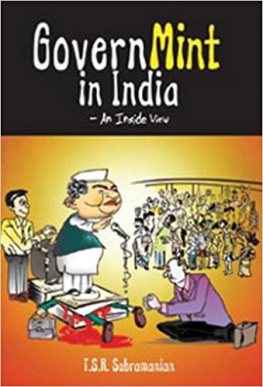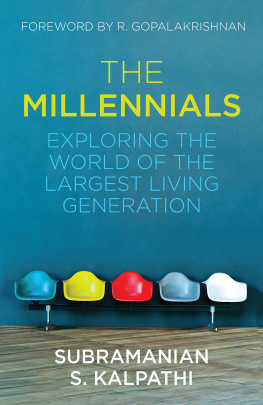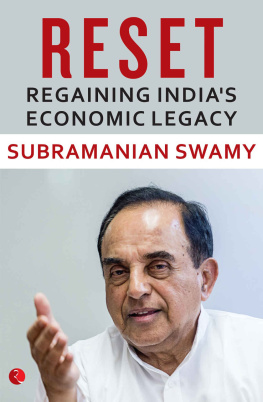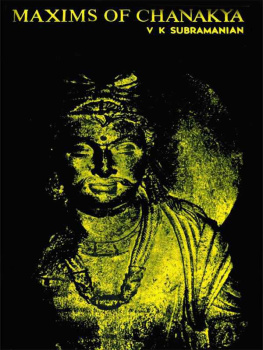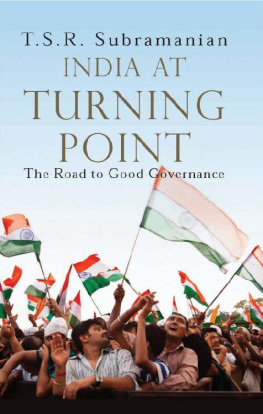T. S. R. Subramanian - GovernMint in India: An Inside View
Here you can read online T. S. R. Subramanian - GovernMint in India: An Inside View full text of the book (entire story) in english for free. Download pdf and epub, get meaning, cover and reviews about this ebook. year: 2009, publisher: Rupa & Co, genre: Politics. Description of the work, (preface) as well as reviews are available. Best literature library LitArk.com created for fans of good reading and offers a wide selection of genres:
Romance novel
Science fiction
Adventure
Detective
Science
History
Home and family
Prose
Art
Politics
Computer
Non-fiction
Religion
Business
Children
Humor
Choose a favorite category and find really read worthwhile books. Enjoy immersion in the world of imagination, feel the emotions of the characters or learn something new for yourself, make an fascinating discovery.
- Book:GovernMint in India: An Inside View
- Author:
- Publisher:Rupa & Co
- Genre:
- Year:2009
- Rating:4 / 5
- Favourites:Add to favourites
- Your mark:
- 80
- 1
- 2
- 3
- 4
- 5
GovernMint in India: An Inside View: summary, description and annotation
We offer to read an annotation, description, summary or preface (depends on what the author of the book "GovernMint in India: An Inside View" wrote himself). If you haven't found the necessary information about the book — write in the comments, we will try to find it.
GovernMint in India: An Inside View — read online for free the complete book (whole text) full work
Below is the text of the book, divided by pages. System saving the place of the last page read, allows you to conveniently read the book "GovernMint in India: An Inside View" online for free, without having to search again every time where you left off. Put a bookmark, and you can go to the page where you finished reading at any time.
Font size:
Interval:
Bookmark:
An Inside View
T.S.R. Subramanian

Copyright T.S.R. Subramanian 2009
Published 2009 by

7/16, Ansari Road, Daryaganj,
New Delhi 110 002
Sales Centres:
Allahabad Bangalooru Chandigarh Chennai
Hyderabad Jaipur Kathmandu
Kolkata Mumbai
All rights reserved.
No part of this publication may be reproduced, stored in a retrieval system, or transmitted, in any form or by any means, electronic, mechanical, photocopying, recording or otherwise, without the prior permission of the publishers.
The author asserts the moral right to be identified as the author of this work.
Typeset by
Mindways Design
1410 Chiranjiv Tower
43 Nehru Place
New Delhi 110 019
Printed in India by
Rekha Printers Pvt Ltd.
A-102/1, Okhla Industrial Area, Phase-II,
New Delhi-110 020
To
Lalitha, Bharti, Amy and
Shankar, Gabriel, Kedar, Anika and
Abhinav
GovernMint In India An Inside View takes a good look at the various Constitutional agencies and other instruments of governance, making an assessment as to how they have performed in relation to the expectations from them at the time India became a Republic. In a sense, this is a stock-taking on Governance of sixty years since Independence.
The three pillars of the Constitution the Legislature, the Judiciary and the Executive have been examined to assess as to how they have performed, in relation to the tasks assigned to them by the Constitution. The author has attempted a micro-analysis of the activities of the players involved in governance as well as the macro-results on the economy, polity and society of India.
This is not a manual or a report proposing a specific agenda for reform. The purpose is to assess the current situation and to reflect whether our institutions have performed to par. The book is also intended to provide basic information on the structure of government and the governance process in India, to the lay reader. The diagnosis described in the book leads up to a number of specific action points. The book could be the starting point for a debate which could lead up to an agenda for reform.
Much of what has been written is based on the personal experience of the author, who has been intimately involved in administration, at different levels, over four decades; while having ten more years to reflect on governance issues from the outside. There is no doubt that the author's perspectives, indeed prejudices, may have gotten reflected in the publication; he has tried hard to be as dispassionate as he could. A number of institutions, agencies, systems, indeed individuals have come in for criticism. This is without malice or intention to humiliate or overly criticise any group or class or individual the author is of the conviction that any aberrations are the results of policy and system failures, and should not merely be attributed to individuals and agencies.
The armed forces, the para-military and the intelligence agencies play a major role in national security, including internal security. They play a vital role in the governance of the nation. Indeed the author has had close exposure to the role played by these institutions, in serving the nation. However, he has preferred not to discuss the role of these agencies, nor any aspect of our national security in this publication public and open discussion of security issues may not always be in the national interest. Good governance should ensure great attention to policy and detail in this regard; a public debate on such issues may be counter productive.
In a sense, the book is a continuation of the author's earlier publication Journeys through Babudom and Netaland,which was well received. The style and approach in this publication are quite different, though governance is a theme common to both. Whereas Journeys through Babudom and Netaland approached the issues anecdotally, GovernMint in India An Inside View is analytical in nature, relating the quality of inputs to results obtained. Without presuming comparing the two books with the great epics and literature of India in any manner, and without any pretensions to comparison and quality, and merely referring to the styles, Journeys through Babudom and Netaland would be like the Mahabharata whereas GovernMint in India An Inside View is of the Bhagvad Gita style. Some friends of the authors has pointed out that the touch of humour seen in the earlier book is somewhat missing this is not surprising; firstly the subject of governance per se is quite serious and 'dry'; secondly the current state of affairs could not be treated with any levity.
A number of anecdotes and incidents referred to in Journeys through Babudom and Netaland have been revisited in GovernMint in India An Inside View, where they naturally fitted in. At many places this has been acknowledged, though there could be some of these without specific reference to the earlier publication.
I acknowledge the assistance rendered to me by Sudhir Sitapati, regarding the structure, contents and approach.
What Ails Governance In India
 t is now sixty-two years since Nehru's 'Tryst with Destiny' speech declaring India's independence as the British left India and handed over its governance to Indians. This period of history has been long enough to take stock of all the developments from then till now, and assess whether what we, as a people, had set out to do has largely been accomplished or not. The question is are we at least on the right track?
t is now sixty-two years since Nehru's 'Tryst with Destiny' speech declaring India's independence as the British left India and handed over its governance to Indians. This period of history has been long enough to take stock of all the developments from then till now, and assess whether what we, as a people, had set out to do has largely been accomplished or not. The question is are we at least on the right track?
The Indian Constitution is a wonderful document. Every time one sees it, or looks at some aspect of it, one gets a new insight about what was intended and what happened since the document came into being. The Constitution is similar to the Bhagvad Gita every reader can find his or her own interpretation in each stanza or article.
In the Preamble, which the citizens have 'given themselves', the Constitution refers to India as a Sovereign, Socialist, Secular, Democratic Republic. By and large, sovereign we have been India has maintained an independent foreign policy and generally, as a nation, conducted itself with dignity and some pride among the nations of the world.
Perhaps, only a few educated persons from the younger generation would be aware that the word 'Socialist' was inserted in the Preamble only in 1977. As many would know, this was when 'Emergency' rule had been declared; there could be questions raised as to why the Constitution was amended in a fundamental way, during that period. An impartial observer could note, with some irony, that India probably was genuinely socialistic before the amendment to the Constitution it was increasingly capitalistic after the amendment! The heyday of the public sector and control of the commanding heights of the economy happened during the period before 1977. The Green Revolution, the cooperative movements, the agrarian reforms in favour of the poor and landless, were all features of the first three decades of Independence, when India was not 'Socialist'. Today, Socialism is considered to be a bad word internationally, as well as to many in India, and this is particularly true after the demise of the Soviet Empire. It was post-1977 that we really saw the Hayek-Friedman model of free enterprise and globalisation becoming the ruling flavour; and continue to be the dominant philosophy governing our economy. Indeed many of our senior leaders, particularly economists, were trained in the London School of Economics or elsewhere abroad on Friedman's theories, and have applied these
Font size:
Interval:
Bookmark:
Similar books «GovernMint in India: An Inside View»
Look at similar books to GovernMint in India: An Inside View. We have selected literature similar in name and meaning in the hope of providing readers with more options to find new, interesting, not yet read works.
Discussion, reviews of the book GovernMint in India: An Inside View and just readers' own opinions. Leave your comments, write what you think about the work, its meaning or the main characters. Specify what exactly you liked and what you didn't like, and why you think so.

